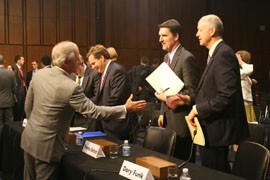Cronkite News has moved to a new home at cronkitenews.azpbs.org. Use this site to search archives from 2011 to May 2015. You can search the new site for current stories.
Arizona’s handling of ‘dual eligible’ health-care patients gets high marks
WASHINGTON – Arizona’s system for providing medical care for “dual eligible” people – those who qualify for both Medicare and Medicaid services – was praised as a promising model for other states at a Senate hearing Wednesday.
Tom Betlach, director of the Arizona Health Care Cost Containment System, told lawmakers that the state’s system of Medicaid managed care for dual-eligibles has saved money and improved care for the “frailest members most in need of care coordination.”
“To expect the most-frail members in the system to have to navigate three different systems, Medicare, Medicare Part D and Medicaid, is just not a good structure,” Betlach said. “As a result we get more expensive costs and poor outcomes.”
Betlach was one of several people testifying before the Senate Special Committee on Aging on the issue of dual-eligibles, who account for a disproportionate amount of health care spending.
In his opening statement, Sen. Herb Kohl, D-Wis., said dual-eligible beneficiaries make up 16 percent of Medicare enrollment but account for 27 percent of spending, while in Medicaid they are 15 percent of enrollees but consume 39 percent of the budget.
He said the 9 million dual-eligibles nationwide account for about $300 billion in spending.
Bringing those costs under control is one of the goals of the Affordable Care Act. The act set up the Medicare-Medicaid Coordination Office to create a more cost-efficient system and “seamless, accountable care” for the dual eligible.
Melanie Bella, the director of the coordination office, testified that it wants to create “a more streamlined system that delivers appropriate quality, cost-effective care.”
The government has turned to the states for ways to do that. The act will fund demonstration projects in 26 states aimed at streamlining an “overcomplicated” and “inefficient” system.
Arizona is not one of those states: Its system has been in place for 32 years and was pointed to Wednesday as a model for others.
“My message to the committee today is that the managed care model being pursued by many states has proven to be a success in Arizona,” Betlach said.
He said that AHCCCS has a “dedicated” staff of 70 to monitor the dual-eligible health plans, which has helped make it a success.
But Dr. Robert Berenson said after the hearing that while Arizona appears to be doing a good job, he has concerns over the Medicare-Medicaid Office’s plan to recruit states to come up with a solution.
“If it were up to me I would be picking the states that I thought were best able to demonstrate that the model works and then try to expand it rather than just taking 26 states and saying, ‘Good luck,’” said Berenson, a fellow at the Urban Institute who testified to the committee.
Despite disagreements on how it should be done, there is a “general recognition that we have to do something” about the healthcare systems, Betlach said.
“The demonstrations are flexible in that it allows states to look at different models. But obviously we want to try and expand on the success that we’ve had already” in Arizona, Betlach said.
While other states embark on the challenge, Arizona will continue to improve and expand its current system, he said.
“As states move forward in this … there’s clearly even more details that we have to work out and so that gives us an opportunity to address some of those concerns,” Betlach said.








